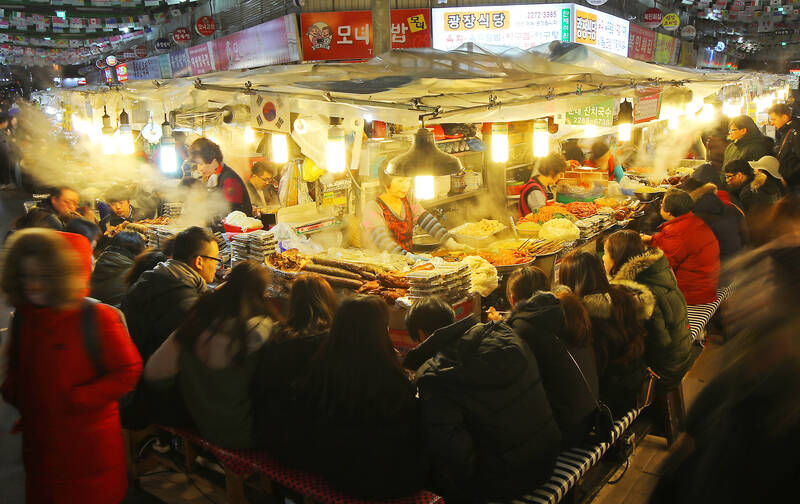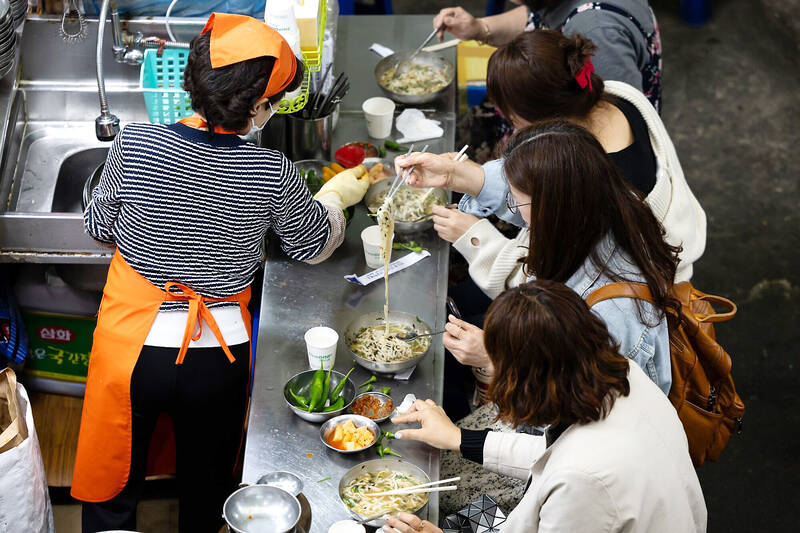“Eighteen years ago, people didn’t even know the name of this ingredient,” says 58-year-old Gil Sa-hyeon, holding up a cluster of dried brownish stems. “Now it’s everywhere.”
His shop, Joseon Yakcho, sits in the heart of Seoul’s Yangnyeongsi Market, South Korea’s largest traditional medicinal herb market, its streets lined with shops displaying buckets of herbs such as licorice root and cinnamon bark that spill on to the pavements, filling the air with their distinct, earthy aroma.
The ingredient Gil is referring to is hovenia dulcis, known in Korean as heotgae — the oriental raisin tree that’s become the cornerstone of South Korea’s booming hangover cure industry.

Photo: EPA-EFE
South Koreans take their hangovers very seriously. For many, the morning-after ritual still involves a steaming bowl of haejangguk, or “hangover soup.”
Often made with napa cabbage, dried pollack or even congealed oxblood, it’s a comfort food as much as a cure, with specialist restaurants opening early for bleary-eyed regulars.
More recently, though, the cure has gone commercial. Walk into any convenience store and you’ll find entire sections dedicated to hangover remedies, from traditional drinks to trendy jelly sticks and tablets designed to ward off the suffering.

Photo: Bloomberg
Most contain extracts of hovenia dulcis, though some use other ingredients said to help, including red ginseng, milk thistle or even seaweed.
The country’s hangover cure market reached approximately 350 billion won (US$256 million) last year, according to NielsenIQ Korea, up 10 percent from the year before.
Despite the market’s growth, South Koreans are actually drinking less, with per-capita alcohol consumption falling steadily since 2015 and post-pandemic shipments of beer and spirits still below 2019 levels.
Analysts link the shift to a combination of factors, from companies cutting back on mandatory after-work boozy sessions to a health-conscious younger generation favoring moderation over binge drinking.
Joo Young-ha, a cultural anthropologist at the Academy of Korean Studies who specializes in food culture, says the appeal of hangover products for younger drinkers is as much social as practical.
“They often buy multiple products in advance to share as gifts during drinking sessions, turning hangover prevention into part of the evening’s etiquette,” he says.
Taeyoung Hwang, an analyst at market research firm Mintel, says that while hangover recovery products remain niche markets globally, South Korea and Japan represent exceptions.
“They have mature and widely adopted hangover recovery product industries deeply tied to their respective drinking cultures,” Hwang says.
According to Mintel’s analysis, South Korea has launched the most hangover products globally in the past five years. Many have become “indispensable daily consumer goods,” with the so-called Korean Wave enabling international expansion.
“The global popularity of Korean culture, including K-pop and K-food, is fueling interest and driving demand for Korean hangover recovery drinks in markets like south-east Asia and beyond,” Hwang says.
While hovenia dulcis appears in classical Chinese medical texts — which historically influenced Korean medical scholarship — it was incorporated into Korean medical literature in later centuries and only recently became a commercial phenomenon, part of a broader movement to retroactively attribute traditional health benefits to modern products.
“Interest in hovenia dulcis for hangover relief only began in the early 1990s, starting with Japanese patents, then Korean scientific research followed,” says Choi Goya from the Korea Institute of Oriental Medicine
TESTING THE CLAIMS
Studies in South Korea have examined various parts of hovenia dulcis for potential detoxifying effects, though evidence remains largely limited to animal research.
In laboratory settings, researchers found fruit extracts of hovenia dulcis reduced blood alcohol concentration in rats, and fermented fruit vinegar reduced levels of both alcohol and acetaldehyde — the toxic compound produced when the body breaks down alcohol.
Scientific literature has also found that the plant increased activity of alcohol dehydrogenase, an enzyme that breaks down alcohol, and may protect the liver from alcohol-related damage.
However, the body of research has major limitations, including studies of different plant parts, a lack of high-quality human clinical trials, and inconsistent quality standards.
Medical researchers remain broadly skeptical about hangover remedies, though a King’s College London systematic review found hovenia dulcis fruit extract among several substances showing statistically significant results in human trials, albeit with very low-quality evidence.
Until recently, Korean companies could make hangover cure claims without needing proof, which prompted local regulators to crack down on the industry.
In January, new rules required companies to conduct human trials showing measurable improvements in things like hangover symptoms and blood alcohol clearance.
Companies that failed to do so have until this month to provide new evidence or face a ban on hangover-related marketing claims entirely.
For many, though, hangover remedies are perhaps less about scientific certainty and more about comfort, routine and the shared culture of drinking.
Lee So-young, a 26-year-old office worker, has been buying hangover products since university.
“I don’t know if they really work,” she says. “But they’re cheap, and sometimes I do actually feel better. That’s good enough for me.”

President William Lai (賴清德) has championed Taiwan as an “AI Island” — an artificial intelligence (AI) hub powering the global tech economy. But without major shifts in talent, funding and strategic direction, this vision risks becoming a static fortress: indispensable, yet immobile and vulnerable. It’s time to reframe Taiwan’s ambition. Time to move from a resource-rich AI island to an AI Armada. Why change metaphors? Because choosing the right metaphor shapes both understanding and strategy. The “AI Island” frames our national ambition as a static fortress that, while valuable, is still vulnerable and reactive. Shifting our metaphor to an “AI Armada”

When Taiwan was battered by storms this summer, the only crumb of comfort I could take was knowing that some advice I’d drafted several weeks earlier had been correct. Regarding the Southern Cross-Island Highway (南橫公路), a spectacular high-elevation route connecting Taiwan’s southwest with the country’s southeast, I’d written: “The precarious existence of this road cannot be overstated; those hoping to drive or ride all the way across should have a backup plan.” As this article was going to press, the middle section of the highway, between Meishankou (梅山口) in Kaohsiung and Siangyang (向陽) in Taitung County, was still closed to outsiders

The older you get, and the more obsessed with your health, the more it feels as if life comes down to numbers: how many more years you can expect; your lean body mass; your percentage of visceral fat; how dense your bones are; how many kilos you can squat; how long you can deadhang; how often you still do it; your levels of LDL and HDL cholesterol; your resting heart rate; your overnight blood oxygen level; how quickly you can run; how many steps you do in a day; how many hours you sleep; how fast you are shrinking; how

“‘Medicine and civilization’ were two of the main themes that the Japanese colonial government repeatedly used to persuade Taiwanese to accept colonization,” wrote academic Liu Shi-yung (劉士永) in a chapter on public health under the Japanese. The new government led by Goto Shimpei viewed Taiwan and the Taiwanese as unsanitary, sources of infection and disease, in need of a civilized hand. Taiwan’s location in the tropics was emphasized, making it an exotic site distant from Japan, requiring the introduction of modern ideas of governance and disease control. The Japanese made great progress in battling disease. Malaria was reduced. Dengue was